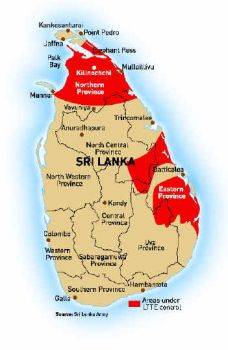Eelam 'Intifada'
by S. Makenthiran
|
Unfortunately, the USA, UK, Australia, and now Canada and EU have thrown their weight in support of the Singhalese. The Western powers have discarded the only leverage that they could exercise to avert a full-scale war.
|
In Tamil, Intifada can be termed Meedpu Nadavadikai. The Eelam Tamils are asking for help in the Eealm Tamil Intifada to rid their homeland of the yoke of the Singhalese army of occupation. The Tamil civilians are the unfortunate victims of the Singhalese army of occupation and the paramilitaries operating with them. Forcible destruction and occupation of Tamil lands, homes, schools, hospitals, places of worship and seas has impoverished the Tamil people for far too long in the areas under Singahlese army occupation. Hundreds of innocent Tamils have been killed, tortured , raped, kidnapped and jailed without trial for long periods.
Eelam Tamils especially would like those from the international community to help them, and there is much that can be done. Writing letters, staging protests and collecting money for refugees and the displaced can make a huge difference to the Eelam Tamils.
About 70 % of the Tamil homeland of Northeast Province (Eelam) is under Tamil administration, but the remaining 30 % of it is under Singhalese army occupation. The Northern part of Jaffna Peninsula, Vavuniya, Trincomalee, some parts of Batticaloa and Mannar remain under Sri Lanakn army control. The Sri Lankan amed forces are 100 % Singhalese, who are strangers and not wanted there. They do not know the language of the indigenous Tamils and Muslims, all of whom speak Tamil. To add to the agony, the Singhalese dominated government are occupying Tamil lands and homes and settling Singhalese from the South in the Tamil homeland. The Sri Lankan armed forces have imposed an economic blockade of Eelam..

Areas under LTTE control
('Frontline', March 2006. Map is probably conservative, especially around Trincomalee)
A ceasefire was declared in 2002, but the Tamil homeland under Tamil control is divided and isolated into three parts – North (Vanni), East (Mutur) and South East (Batticaloa). Before and after the election of Mahinda Rajapakse, a subversive war, a shadow war, was being fought by the government and the Tamils. From the beginning of 2006, the conflict developed into a low intensity war, and gradually the situation has worsened into a war of attrition by proxy. The paramilitary attacks backed by the SL Intelligence are taking a toll on the Tamil cvivilians. The Tamil Resurgence is becoming formidable. The civilian resistance movements have killed many of the armed forces. Some Singhalese civilians, too, have been killed by unknown parties. The Singhalese accuse the LTTE of all the killings, but they deny it.
Unfortunately, the USA, UK, Australia, and now Canada and EU have thrown their weight in support of the Singhalese. The Western powers have discarded the only leverage that they could exercise to avert a full-scale war. India is wavering, but Tamil Nadu is keeping the Central
G
overnment on a tight rope. Japan and Norway, by keeping neutral, may be of help in maintaining the ceasefire. Switzerland, New Zealand and Iceland may, by maintaining neutrality, help Norway in monitoring the ceasefire.
Banning the Tamil Tigers to satisfy the Singhalese is counter productive. Unless the Singhalese army of occupation vacates the Tamil homeland, or at least are confined to barracks, the danger of war is real. The recognition of the Tamil homeland is long overdue.

Prabaharan at Heros’ Day
In his 2005 Heroes' Day speech, Prabaharan allaying fears of an impending war, gave the newly elected President Mahinda Rajapakse one year’s time to solve the ethnic problem. Niupama Subramaniam, a daughter of a maverick Tamil Nadu politician, referred to the LTTE leader dismissively as an aging guerilla. Ironically, she mistook the tiger leader avoiding immediate war as a sign of weakness. Trust me – don’t mess around with a Tiger, even an aging one.
|
 Home
Home Archives
Archives Home
Home Archives
Archives